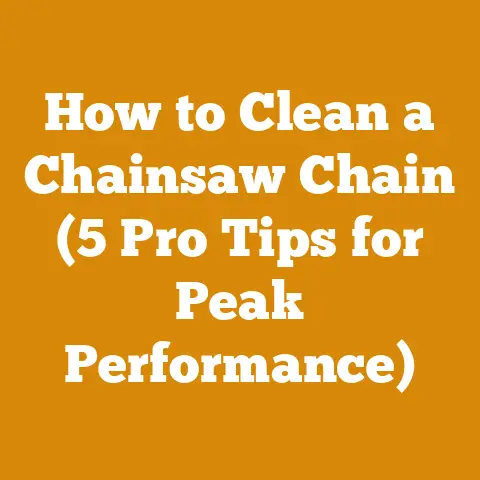How to Tie a Bowline on the Bight (5 Pro Arborist Tips)
Alright, let’s dive deep into the world of knot tying, specifically the Bowline on a Bight. While I’m a big fan of low-maintenance options in many areas of life – think electric chainsaws for quick firewood prep or splitters that take the grunt work out of processing – there are certain skills that are undeniably valuable and require a bit of hands-on practice. Knot tying, especially when working with ropes in demanding situations like tree work or logging, falls squarely into that category.
I’ve spent years in the woods, both professionally and as a dedicated enthusiast. From felling trees to rigging loads, I’ve learned that a solid knot can be the difference between a successful operation and a dangerous situation. This article isn’t just about reciting steps; it’s about sharing the practical knowledge and pro tips I’ve gathered along the way.
Key Takeaways:
- You’ll learn the Bowline on a Bight, a crucial knot for creating a secure loop in the middle of a rope without access to the ends.
- I’ll share five pro arborist tips to improve your knot-tying speed, security, and overall rope handling skills.
- You’ll understand the advantages of the Bowline on a Bight over other knots and when it’s the best choice for your needs.
- We’ll cover essential safety considerations and best practices for using this knot in demanding environments.
- I’ll provide real-world examples and scenarios where the Bowline on a Bight has proven invaluable in my own experience.
The Bowline on a Bight: A Knot for All Seasons (and Situations)
The Bowline on a Bight is a variation of the classic Bowline knot, but with a crucial difference: it can be tied in the middle of a rope, creating a loop without needing access to either end. This makes it incredibly versatile in situations where you need a secure loop, but the rope ends are already fixed or inaccessible.
Think about it: you’re high up in a tree, rigging a branch for controlled descent. You need a strong loop to attach your rigging hardware, but you can’t simply use a regular Bowline because the rope is already running through your lowering device. That’s where the Bowline on a Bight comes in.
Why the Bowline on a Bight Matters
- Strength: When tied correctly, the Bowline on a Bight retains a significant portion of the rope’s breaking strength. While the exact percentage varies depending on the rope material and tying technique, it generally holds around 60-70% of the rope’s original strength. This is crucial when dealing with heavy loads and potentially dangerous situations.
- Security: The Bowline on a Bight is known for its reliability. It’s unlikely to slip or come undone under load, provided it’s tied properly. However, it’s always a good practice to “dress” the knot neatly and check it visually before applying any weight.
- Versatility: As I mentioned earlier, the ability to tie this knot in the middle of a rope opens up a wide range of applications. From creating anchor points to rescue scenarios, the Bowline on a Bight is a valuable tool in any rope worker’s arsenal.
- Ease of Untying: Even after being heavily loaded, the Bowline on a Bight is generally easy to untie. This is a significant advantage over some other knots that can become jammed and difficult to release.
Tying the Bowline on a Bight: A Step-by-Step Guide
Okay, let’s get down to the nitty-gritty. I’ll walk you through the steps of tying the Bowline on a Bight, and then we’ll get to the pro tips that will really elevate your knot-tying game.
- Form a Bight: Start by taking the rope and forming a bight (a loop) in the middle of it. The size of the bight will determine the size of the loop you create.
- Pass the Bight Through: Hold the bight and pass it behind the standing part of the rope (the part that will bear the load).
- Create a Small Loop: Now, take the bight and pass it back through the loop you just created. This forms a smaller loop above the larger one.
- Pass the Bight Over: Take the entire bight and pass it over the larger loop, essentially flipping it over the top.
- Tighten and Dress: Hold the standing part of the rope and pull the bight to tighten the knot. Dress the knot neatly, ensuring that the strands are aligned and there are no twists or kinks.
Visual Aid: If you’re having trouble visualizing these steps, I highly recommend searching for a video tutorial of the Bowline on a Bight. Seeing the process in action can make a big difference.
5 Pro Arborist Tips for Mastering the Bowline on a Bight
Now that you know how to tie the knot, let’s move on to the tips that will help you tie it faster, more securely, and with greater confidence. These are the things I’ve learned from years of experience in the field, working alongside seasoned arborists and rigging professionals.
Tip #1: The One-Handed Method (for When You’re Hanging in a Tree)
One of the most valuable skills I’ve learned is how to tie the Bowline on a Bight with one hand. This is essential when you’re working at height and need to keep one hand free for balance or to hold onto a branch.
Here’s how to do it:
- Drape the Rope: Drape the rope over your shoulder or around a secure anchor point, leaving a sufficient length to work with.
- Form the Bight: Using your working hand, form a bight in the rope.
- Pinch and Twist: Pinch the bight between your thumb and forefinger, and then twist your hand to create a small loop.
- Pass and Tighten: Pass the bight through the small loop and then over the larger loop, as you would in the standard method. Tighten the knot by pulling on the standing part of the rope.
This technique takes practice, but it’s a game-changer when you need to tie the knot quickly and efficiently in challenging situations.
Personal Story: I remember one time I was suspended about 40 feet up in a large oak tree, rigging a heavy limb for removal. My lanyard was secured, but I needed to tie a Bowline on a Bight to attach a pulley. I tried to use both hands, but it was awkward and unstable. That’s when I remembered a seasoned arborist showing me the one-handed method. After a few fumbled attempts, I managed to tie the knot securely, and it made the whole process much smoother and safer.
Tip #2: The “Rabbit Comes Out of the Hole” Mnemonic (with a Twist)
You’ve probably heard the classic mnemonic for tying a regular Bowline: “The rabbit comes out of the hole, goes around the tree, and back down the hole.” While that works for the standard Bowline, it doesn’t quite translate to the Bowline on a Bight.
Here’s my adapted version:
“The double rabbit comes out of the hole, goes around the tree, and both rabbits go back down the hole.”
This emphasizes the fact that you’re working with a bight (a double strand) and that both strands need to pass back through the loop. It’s a simple tweak, but it can help you visualize the process more clearly.
Tip #3: Practice with Different Rope Types
Not all ropes are created equal. The Bowline on a Bight will behave differently depending on the rope’s material, diameter, and construction. I’ve worked with everything from stiff, synthetic ropes to soft, natural fiber ropes, and each presents its own challenges.
- Synthetic Ropes (e.g., Polyester, Nylon): These ropes are generally stronger and more resistant to abrasion than natural fiber ropes. However, they can also be more slippery, which can make the knot more prone to loosening if not tied properly.
- Natural Fiber Ropes (e.g., Manila, Sisal): These ropes are often more textured, providing better grip and making the knot more secure. However, they’re also more susceptible to rot and degradation, especially when exposed to moisture.
Recommendation: Practice tying the Bowline on a Bight with a variety of rope types to get a feel for how each one behaves. This will help you develop the muscle memory and intuition needed to tie the knot correctly in any situation.
Tip #4: The Importance of “Dressing” the Knot
“Dressing” a knot simply means arranging the strands neatly and ensuring that they’re properly aligned. This is a crucial step that’s often overlooked, but it can significantly improve the knot’s strength and security.
Here’s what to look for when dressing a Bowline on a Bight:
- No Twists or Kinks: Make sure that the strands are running smoothly and there are no twists or kinks that could weaken the knot.
- Even Distribution of Load: Ensure that the load is distributed evenly across all the strands of the knot. This will prevent any one strand from bearing too much weight and potentially failing.
- Tighten Gradually: Tighten the knot gradually, pulling on each strand in turn to ensure that it’s snug and secure.
Expert Insight: I once spoke with a rope manufacturer who told me that a poorly dressed knot can reduce the rope’s breaking strength by as much as 20%. That’s a significant reduction, and it highlights the importance of taking the time to dress your knots properly.
Tip #5: The Backup Knot (for Added Security)
Even though the Bowline on a Bight is a reliable knot, it’s always a good practice to add a backup knot for extra security, especially when working with heavy loads or in potentially dangerous situations.
A simple overhand knot tied in the tail of the rope, close to the main knot, can prevent the Bowline on a Bight from coming undone if it were to slip or loosen. This is a small precaution that can make a big difference in terms of safety and peace of mind.
Bowline on a Bight vs. Other Knots: When to Choose It
The Bowline on a Bight is a great knot, but it’s not always the best choice for every situation. Let’s compare it to some other common knots and see when it shines.
- Regular Bowline: The regular Bowline is simpler to tie and generally stronger than the Bowline on a Bight. However, it requires access to the end of the rope, which limits its versatility. Choose the regular Bowline when you need a strong, secure loop and you have access to the rope end.
- Figure Eight Loop: The Figure Eight Loop is another strong and reliable loop knot. It’s slightly more complex to tie than the Bowline on a Bight, but it’s also less likely to loosen under fluctuating loads. Choose the Figure Eight Loop when you need a highly secure loop and you’re willing to spend a bit more time tying it.
- Butterfly Loop: The Butterfly Loop is similar to the Bowline on a Bight in that it can be tied in the middle of a rope. However, it’s generally considered to be less strong and less secure than the Bowline on a Bight. Choose the Butterfly Loop when you need a loop in the middle of a rope but strength is not a primary concern.
Decision Matrix:
| Knot | Strength | Security | Ease of Tying | Requires Rope End | Best Use Case |
|---|---|---|---|---|---|
| Regular Bowline | High | High | Easy | Yes | Creating a loop at the end of a rope for general use. |
| Bowline on Bight | Medium | Medium | Moderate | No | Creating a loop in the middle of a rope when the ends are inaccessible. |
| Figure Eight Loop | High | High | Moderate | Yes | Creating a highly secure loop for climbing or rigging. |
| Butterfly Loop | Low | Low | Easy | No | Creating a loop in the middle of a rope when strength is not a primary concern. |
Safety Considerations and Best Practices
Working with ropes and knots can be dangerous if you’re not careful. Here are some essential safety considerations and best practices to keep in mind when using the Bowline on a Bight:
- Inspect Your Rope: Before each use, thoroughly inspect your rope for any signs of damage, such as cuts, abrasions, or discoloration. Discard any rope that is damaged or worn. A study by the Cordage Institute found that over 60% of rope failures are due to pre-existing damage that was not detected.
- Use the Right Rope for the Job: Choose a rope that is appropriate for the load you’ll be lifting and the environment you’ll be working in. Consider factors such as rope material, diameter, and breaking strength.
- Tie Knots Correctly: Practice tying the Bowline on a Bight until you can do it consistently and correctly. Don’t rely on memory alone; refer to a guide or video tutorial if you’re unsure of the steps.
- Dress Your Knots: As I mentioned earlier, dressing your knots is crucial for ensuring their strength and security. Take the time to arrange the strands neatly and tighten the knot properly.
- Use a Backup Knot: Add a backup knot for extra security, especially when working with heavy loads or in potentially dangerous situations.
- Be Aware of Environmental Factors: Environmental factors such as moisture, sunlight, and chemicals can weaken ropes over time. Store your ropes in a cool, dry place and protect them from exposure to harmful elements.
- Get Professional Training: If you’re working with ropes in a professional setting, such as tree work or rigging, consider getting professional training from a certified instructor.
Real-World Example: I once witnessed a near-miss accident where a rope failed during a tree removal operation. The rope had been exposed to sunlight for an extended period, and it had weakened significantly. Fortunately, the arborist was using a backup knot, which prevented the load from falling completely. This incident served as a stark reminder of the importance of rope inspection and proper storage.
Conclusion: Knot Tying as a Foundational Skill
Mastering the Bowline on a Bight is more than just learning a knot; it’s about developing a foundational skill that can be applied in a wide range of situations. Whether you’re an arborist, a logger, a sailor, or simply someone who enjoys spending time outdoors, the ability to tie a secure and reliable knot is an invaluable asset.
By following the steps and tips I’ve shared in this article, you can improve your knot-tying skills and gain the confidence to tackle even the most challenging rope work tasks. Remember to practice regularly, inspect your ropes carefully, and always prioritize safety.
Next Steps:
- Practice, Practice, Practice: The best way to master the Bowline on a Bight is to practice it regularly. Tie it several times a day until you can do it without thinking.
- Experiment with Different Ropes: Try tying the knot with different types of ropes to get a feel for how each one behaves.
- Seek Feedback: Ask an experienced rope worker to watch you tie the knot and provide feedback on your technique.
- Apply Your Skills: Look for opportunities to use the Bowline on a Bight in real-world situations. The more you use it, the more comfortable and confident you’ll become.
I hope this article has been helpful and informative. Remember, knot tying is a skill that takes time and dedication to master, but the rewards are well worth the effort. So grab a rope, start practicing, and get ready to unlock a whole new world of possibilities.






